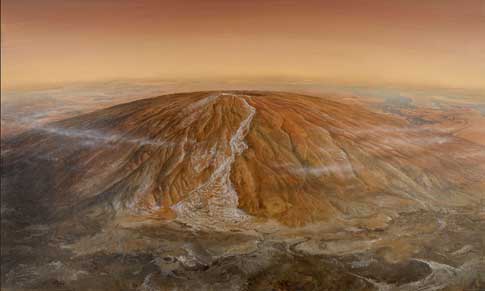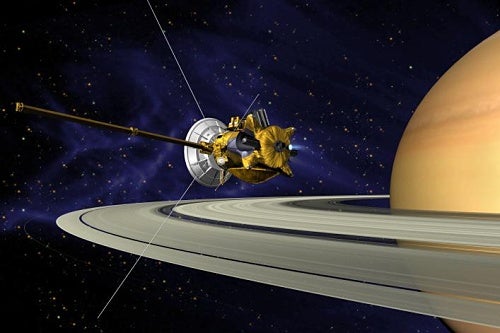Evidence from NASA’s Cassini spacecraft suggests Neptune’s Triton may not be the only satellite with cryovolcanism. Saturn’s moon Titan may be cryovolcanic as well. Long before Cassini settled into orbit around Saturn June 30, 2004, planetary geologists suspected super-chilled cryovolcanoes lurk beneath Titan’s surface.
The Cassini orbiter’s radar and infrared mapping of planet-size Titan reveal features that remind scientists of volcanic structures on other worlds. The most remarkable to date is a 120-mile-wide (180 kilometers) circular feature called Ganesa Macula. Although no topographic data has yet been obtained, the mountain resembles volcanoes on Venus or Earth — specifically pancake domes or shield volcanoes, like those common in Hawaii. Titan’s Ganesa is about the same scale as large shield volcanoes on Earth. For reference, the world’s largest shield volcano, Mauna Loa, rises 14,000 feet (4,300 meters) above sea level.
Ganesa’s dome appears to have a relatively flat top, steep flanks, and a central depression about 13 miles (20 km) across. Researchers interpret this depression as a volcanic caldera (basin-shape depression), Rosaly Lopes of NASA’s Jet Propuslion Laboratory (JPL) says. Sinuous channels wind their way down the mountainside from the central crater, “possibly cryolava channels running down the flanks.”
Additionally, “Flow features that appear to have erupted from the dome are also preferentially located on the south and eastern sides,” says Lopes. This implies the presence of a gradient. If Ganesa is, indeed, the smoking gun for Titan volcanism, its flanks may be laced with “lava” flows of water, which may slump down the mountainside like terrestrial glaciers.
This latest evidence builds on circumstantial evidence that initially led planetary geologists to believe cryovolcanism occurs on Titan.
First, Titan’s size (3,200 miles [5,150 kilometers] wide, about 40 percent the size of Earth) and mass suggest it harbors a great deal of internal heat. Some of the heat is left over from the moon’s formation, and radioactive elements generate the rest.
Second, Titan’s somewhat elliptical orbit around Saturn may result in a more subtle type of tidal friction than what causes volcanism on Jupiter’s moon Io.
Finally, Titan is the only moon in the solar system with a substantial atmosphere. Titan’s thick fog, 1.5 times the density of Earth’s atmosphere, blankets the moon in an opaque orange veil. This veil comprises primarily nitrogen, with some methane.
The small amount of methane in Titan’s atmosphere intrigues planetary geologists. Says Lopes, “Because methane is photo-dissociated in Titan’s atmosphere and forms organics such as ethane, propane, and acetylene, it must be replenished somehow.” Some researchers suggest lakes or even seas of liquid methane or ethane could be re-supplying the atmospheric methane.
Cassini’s Synthetic Aperture Radar mapped features that appear to be drainage networks, river valleys, and dark spots on the surface that resemble bodies of liquid, or areas that were recently filled. Although these bodies could contribute to the atmospheric methane, cryovolcanism now seems a more likely candidate.











